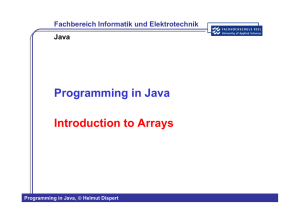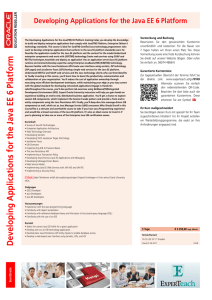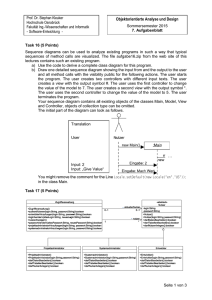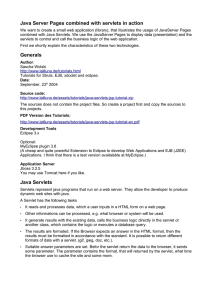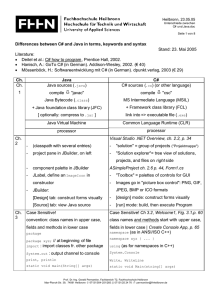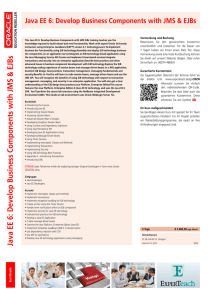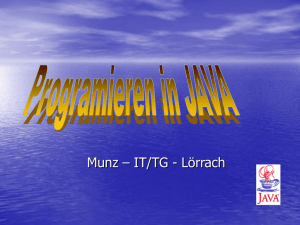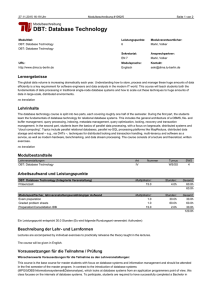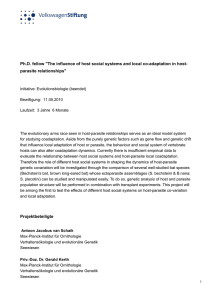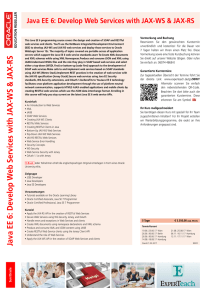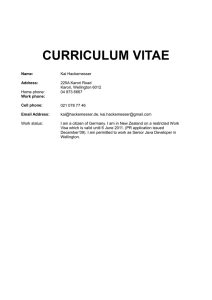Java Servlets
Werbung
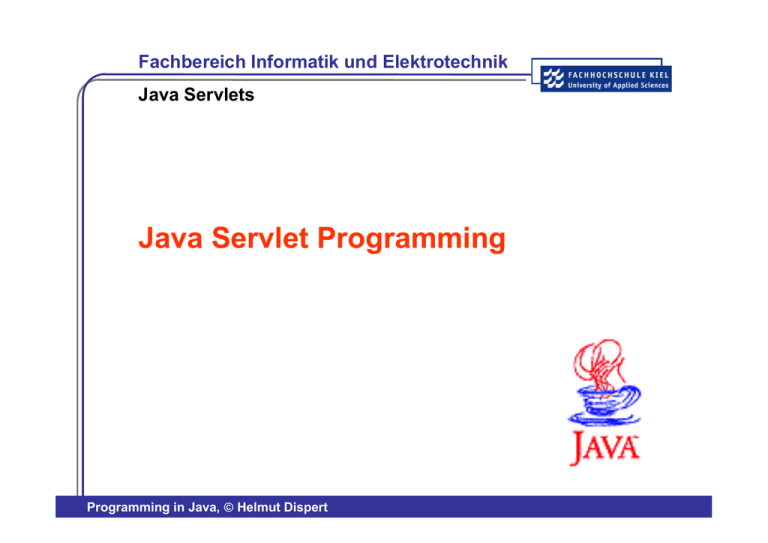
Fachbereich Informatik und Elektrotechnik
Java Servlets
Java Servlet Programming
Programming in Java, Helmut Dispert
Fachbereich Informatik und Elektrotechnik
Java 2 Platform Editions
JavaCard
Java Technology
Enabled Devices
Java Technology
Enabled Desktop
Micro
Edition
Programming in Java, Helmut Dispert
Standard
Edition
Workgroup
Server
High-End
Server
Enterprise
Edition
Fachbereich Informatik und Elektrotechnik
Java 2 Platform
Profile
Profile Profile
Profile
Profile
Profile Profile
Profile
Java
Java22
Enterprise
Enterprise
Edition
Edition
(J2EE)
(J2EE)
Core
CoreAPIs
APIs
Java
Java22
Standard
Standard
Edition
Edition
(J2SE)
(J2SE)
Core
CoreAPIs
APIs
Java 2 Platform, Micro Edition
(J2ME) encompasses VMs and core
APIs specified via Configurations as
well as vertical – or market-specific
APIs specified in Profiles.
TV
TV
Profile
Profile
Screen
Screen Car
Car
Phone
Phone Profile
Profile
Profile
Profile
Personal
Personal
Profile
Profile
Mobile Information
Mobile
DeviceInformation
Profile
Device Profile
Java
Java22Micro
MicroEdition
EditionCore
CoreAPIs
APIs
Smart
Smart
Card
Card
Profile
Profile
Java
JavaProgramming
ProgrammingLanguage
Language
Java
JavaHotSpot
HotSpot
Java
JavaVirtual
VirtualMaschine
Maschine(JVM)
(JVM)
Programming in Java, Helmut Dispert
KVM
KVM
Card
CardVM
VM
Fachbereich Informatik und Elektrotechnik
Java Technology / Range of Devices
Programming in Java, Helmut Dispert
Fachbereich Informatik und Elektrotechnik
J2EE Platform
EJBs
EJBs
Application
ApplicationProgramming
ProgrammingModel
Model
JSPs
JSPs Servlets
Servlets
Container
Container
Transactions
Transactions
Messaging
Messaging
Mail
Mail
Java
Java22SDK,
SDK, Standard
StandardEdition
Edition
CORBA
CORBA
RMI
RMI
Programming in Java, Helmut Dispert
Database
Database
Naming
Naming/ /Directory
Directory
Connectors
Connectors
Applets
Applets
JavaBeans
JavaBeans
Tools
Tools
Fachbereich Informatik und Elektrotechnik
JAVA 2 EE
• Standard platform for web applications J2EE platform
released December 1999.
• HTML presentation APIs
Servlet 2.2
JavaServer Pages 1.1
2008: Servlet 2.5 and JSP 2.1 specifications
• Many other subsystems standardized under a single
platform
EJB and JDBC technologies
JTA, JTS, JMS, JavaMail API, RMI-IIOP
RMI:
IIOP:
Remote Method Invocation, JTA:
Internet Inter-Orb Protocol, JTS:
JMS:
Programming in Java, Helmut Dispert
Java Transaction API
Java Transaction Service API
Java Message Service API
Fachbereich Informatik und Elektrotechnik
Jakarta - Tomcat
Jakarta Project
The goal of the Jakarta Project is to provide commercialquality server solutions based on the Java Platform that
are developed in an open and cooperative fashion.
Jakarta is the "overall" project for many subprojects. For
example, Tomcat is the Servlet+JSP Engine which is a
subproject of the Jakarta Project.
Programming in Java, Helmut Dispert
Fachbereich Informatik und Elektrotechnik
Jakarta - Tomcat
Jakarta Tomcat
Tomcat is the servlet container that is used in the official
Reference Implementation for the Java Servlet and
JavaServer Pages technologies. The Java Servlet and
JavaServer Pages specifications are developed by Sun
under the Java Community Process.
Tomcat is developed in an open and participatory
environment and released under the Apache Software
License.
Programming in Java, Helmut Dispert
Fachbereich Informatik und Elektrotechnik
Standard Services and APIs
Presentation
Business
Logic
Data
Access
Servlet
Java Server Pages
EJB
JDBC
Data
Client
JTS/JTA
JNDI
JavaMail
RMI-IIOP
Java 2 Enterprise Edition APIs
Programming in Java, Helmut Dispert
JMS
Fachbereich Informatik und Elektrotechnik
What Are Servlets?
• Java technology objects which extend the
functionality of an HTTP Server.
• Comparable to Netscape’s NSAPI, Microsoft’s
ISAPI, or Apache Modules
• Platform Independent
• Server Independent
Programming in Java, Helmut Dispert
Fachbereich Informatik und Elektrotechnik
What Are Servlets?
Web Server
Multiple requests
In a single session
Servlet Engine Container
Request
URL1
Servlet
1
URL2
Servlet
2
Response
Request
Browser
Response
Programming in Java, Helmut Dispert
Fachbereich Informatik und Elektrotechnik
Servlets
• Servlets run inside a JVM on the server
• Requests are handled by separate Threads within the web
server process.
• Servlets can interact very closely with the server.
• Servlets can provide thin-client connectivity to a large
enterprise application. Since servlets reside on the server,
they can act as a middleware gateway to legacy systems.
• Servlets can provide controlled access to a number of
different multi-user applications, such as chat servers,
news and file services, discussion databases, and search
engines.
Programming in Java, Helmut Dispert
Fachbereich Informatik und Elektrotechnik
Why Servlets?
• HTTP is the universal transport of the Internet through
restrictive firewalls
• Browsers, Web Applications, Java technology-based
applets and Applications, and other programs can all use
HTTP
• Any kind of data can be transmitted over HTTP - not just
HTML
Programming in Java, Helmut Dispert
Fachbereich Informatik und Elektrotechnik
Java Servlets
From CGI to Servlet
Programming in Java, Helmut Dispert
Fachbereich Informatik und Elektrotechnik
CGI (Common Gateway Interface) – Life Cycle
Main
Process
Request for CGI 1
Child Process
for CGI 1
Request for CGI 2
Child Process
for CGI 2
Request for CGI 1
Child Process
for CGI 1
CGI-based
Web Server
Example: CGI script written in Perl
Each request starts a separate Perl interpreter
Programming in Java, Helmut Dispert
Fachbereich Informatik und Elektrotechnik
FastCGI – Life Cycle
Main
Process
Request for CGI 1
Child Process
for CGI 1
Request for CGI 2
Child Process
for CGI 2
Request for CGI 1
FastCGI-based
Web Server
FastCGI creates a single persistent process
for each FastCGI program.
Programming in Java, Helmut Dispert
Fachbereich Informatik und Elektrotechnik
Server Extension APIs – Life Cycle
Main Process
Request for
Server Extension 1
Server Extension 1
Request for
Server Extension 2
Server Extension 2
Request for
Server Extension 1
Web Server with Server Extension API
Programming in Java, Helmut Dispert
Fachbereich Informatik und Elektrotechnik
Server Extension APIs
Examples:
• Netscape’s NSAPI (WAI)
• Microsoft’s ISAPI
• Apache Modules
Server extensions enhance or change the base
functionality of the server
Proprietary solutions
Server-specific APIs use linked C or C++ code
Security and reliability hazards
Programming in Java, Helmut Dispert
Fachbereich Informatik und Elektrotechnik
ASP, JavaScript
Active Server Pages - ASP (Microsoft):
Technique for developing dynamic web content;
HTML page contains snippets of embedded code
(VBScript, Jscript, etc.);
Supported by Microsoft IIS (Internet Information Server)
and other web servers.
Server-side JavaScript - SSJS (Netscape):
Technique for developing dynamic web content;
HTML page contains snippets of embedded JavaScript
code;
For higher performance the web pages are precompiled.
Programming in Java, Helmut Dispert
Fachbereich Informatik und Elektrotechnik
Java Servlet – Life Cycle
Main Process
JVM
Request for
Servlet 1
Thread
Servlet 1
Thread
Request for
Servlet 2
Thread
Servlet 2
Request for
Servlet 1
Java Servlet-based Web Server
Programming in Java, Helmut Dispert
Fachbereich Informatik und Elektrotechnik
Servlet Advantages over CGI
• Efficient
Threads instead of OS processes, one servlet copy,
persistence
• Convenient
Many high-level utilities
• Powerful
Sharing data, pooling, persistence
• Portable
run on virtually all operating systems and servers
• Secure
No shell escapes, no buffer overflows
Programming in Java, Helmut Dispert
Fachbereich Informatik und Elektrotechnik
Servlet Advantages over CGI
• Architecturally Faster than CGI
Servlets don’t fork a new process for each request
Servlets are loaded and ready for each request
The same servlet can handle many requests
• Easy to Develop
Based on Java programming language
No pointer problems like C code
No different dialects of development language for
different databases
Object Oriented
Servlets lend themselves to reusable code practices
Programming in Java, Helmut Dispert
Fachbereich Informatik und Elektrotechnik
Servlet Advantages over CGI
• Extensive Java Libraries Available
The functionality of the Java platform libraries make
Servlets the most flexible middle tier
Servlets can take advantage of JDBC, EJB, JMS,
JavaMail, JavaIDL, RMI, and more
Any third-party Java technology-based library is easily
accessible
• Write Once, Run Anywhere
Servlets can run on any platform that the Java Runtime
exists
The same servlet can run on any brand of server
Develop on any small desktop machine, Deploy on the
largest of servers
Programming in Java, Helmut Dispert
Fachbereich Informatik und Elektrotechnik
Free Servlet and JSP engines
Apache Tomcat
http://jakarta.apache.org/tomcat/
SUN JSWDK
http://java.sun.com/products/servlet/download.html/
IBM WebSphere Application Server
http://www.software.ibm.com/webservers
Allaire JRUN
http://www.jrun.com/
Unify ServletExec
http://www.servletexec.com
Gefion Software LiteWebserver
http://www.gefionsoftware.com/LiteWebServer/
Servlet Engines
Programming in Java, Helmut Dispert
Fachbereich Informatik und Elektrotechnik
Compiling and Invoking Servlets
• Set CLASSPATH
Servlet JAR file (e.g. servlet.jar)
JSP JAR file (e.g. jasper.jar, jspengine.jar, jsp.jar)
top of your package hierarchy
• Put servlet class path on proper location
(location depends on server) e.g.:
TOMCAT:
host/webapps/ROOT/WEB-INF/classes
• Invoke servlets:
http://host/servlet/ServletName
Programming in Java, Helmut Dispert
Fachbereich Informatik und Elektrotechnik
Servlet Engines for Existing Servers
• Standalone Servlet Engines
Servers with built-in support for servlets:
Sun Microsystem Java Web Server, Netscape Enterprise
Server, W3C Jigsaw Server, O'Reilly WebSite Pro
• Add-on Servlet Engines
Plug-in to an existing server:
Apache Tomcat, WAICoolRunner for Netscape,
Life Software JRun
• Embeddable Servlet Engines
Lightweight servlet platform that can be embedded in
another application:
Sun Microsystem JavaServer Engine
Programming in Java, Helmut Dispert
Fachbereich Informatik und Elektrotechnik
Three-tier Architecture
Presentation
Level
Clients
Content Level
Data and Service Level
Three-tier architecture for application service providers (ASP):
focused on accessing information.
Programming in Java, Helmut Dispert
Web Server
Relational
Database
Fachbereich Informatik und Elektrotechnik
Multitier Architecture
Presentation
Level
Clients
Content Level
Web Server
Application Level
Application
Server
Data and
Service Level
Relational Databases
Other Systems
Multitier (Internet-based) architecture for application service providers (ASP):
focused on accessing application services.
Programming in Java, Helmut Dispert
Fachbereich Informatik und Elektrotechnik
Three-tier servlet model
Java Web
Server
DB
Server
Servlet
Servlet
Servlet
Web Clients
DB:
AS:
ORB:
Database Server
Application Server
Object Request Broker
Programming in Java, Helmut Dispert
Custom
AS
ORB
Fachbereich Informatik und Elektrotechnik
Java Servlets
Client
HTTP-Server
Database
Browsers
Applets
Servers
Servlets
Programming in Java, Helmut Dispert
Fachbereich Informatik und Elektrotechnik
Java Servlets
Operating System
Server
Service
e.g. HTTP
Service
e.g. FTP
Servlet
Servlet
Servlet
Servlet
Programming in Java, Helmut Dispert
Fachbereich Informatik und Elektrotechnik
Servlet Package / Servlet API
The javax.servlet package provides interfaces
and classes for writing servlets.
All servlets implement the Servlet interface.
Most common way:
extending a class that implements the Servlet
interface
(e.g. HttpServlet).
Programming in Java, Helmut Dispert
Fachbereich Informatik und Elektrotechnik
The Servlet Interface
Servlet
Servlet
GenericServlet
GenericServlet
HttpServlet
HttpServlet
MyServlet
MyServlet
Programming in Java, Helmut Dispert
Servlet Documentation
Fachbereich Informatik und Elektrotechnik
Client Interaction
Call
Client
Servlet
Servlet receives two objects:
1. ServletRequest:
encapsulates the communication from the
client to the server.
2. ServletResponse:
encapsulates the communication from the
servlet back to the client.
ServletRequest and ServletResponse are
interfaces defined by the javax.servlet package
Programming in Java, Helmut Dispert
Fachbereich Informatik und Elektrotechnik
HTTP – Hypertext Transport Protocol
HTTP:
Stateless protocol (simple)
Client specifies HTTP command (method)
request also specifies URL and HTTP version
Example: GET command
GET /example.html HTTP/1.0
URL
(address)
Programming in Java, Helmut Dispert
Protocol
version
Fachbereich Informatik und Elektrotechnik
HTTP – Request
After the initial request the client can send optional
information about the request (software, content type,
etc.):
Optional header information
Example:
User-Agent: Mozilla/4.0 (compatible; MSIE 4.0; Windows 95)
Accept: image/gif, image/jpeg, text/*, */*
User-Agent header:
Information about the client software
Accept header:
Specification of the media (MIME)
Programming in Java, Helmut Dispert
Fachbereich Informatik und Elektrotechnik
HTTP – Request
Request Information Example
Method:
GET
Request URI:
/dispert/servlet/RequestInfoExample
Protocol:
HTTP/1.0
Path Info:
null
Remote Address:
149.222.10.2
Programming in Java, Helmut Dispert
Fachbereich Informatik und Elektrotechnik
HTTP – Request
Request Header Example
Host
Referer
149.222.51.80:8080
http://149.222.51.80:8080/
dispert/servlets/index.html
Accept-Encoding gzip
Accept
image/gif, image/x-xbitmap,
image/jpeg, image/pjpeg,
image/png, */*
Connection
Keep-Alive
Accept-Charset iso-8859-1,*,utf-8
User-Agent
Mozilla/4.7 [en] (Win98; U)
Accept-Language en
Ref.: W3C
The Referer request-header field allows the client to specify, for the server's benefit, the address (URI) of the
resource from which the Request-URI was obtained (the "referrer", although the header field is misspelled.)
Programming in Java, Helmut Dispert
Fachbereich Informatik und Elektrotechnik
HTTP – Request
After the headers, the client sends a blank line.
The client can also send additional data, if this is
appropriate for the method being used (e.g. with the
POST method).
After the client sends the request, the server processes
it and sends back a response
The first line is a status line that specifies the server's
HTTP version, a status code and the code description,
e.g.:
HTTP/1.0 200 OK
Programming in Java, Helmut Dispert
Fachbereich Informatik und Elektrotechnik
HTTP – Response
Response Header:
Status code (line), status description
Examples:
HTTP/1.0 200 OK
Status code: 200
Request was successful
HTTP/1.0 404 Not Found
Status code: 404
Requested document was not found
Programming in Java, Helmut Dispert
Fachbereich Informatik und Elektrotechnik
HTTP – Response
Response Headers:
Software running on server
Content type of server response
Example:
Date: Sunday 11-June-2000 04:14:12 GMT
Server: JavaWebServer/1.1.1
MIME-Version: 1.0
Content-type: text/html
Content-length:1029
Last-modified: Thursday 7-May-2000 12:15:35 GMT
Programming in Java, Helmut Dispert
Fachbereich Informatik und Elektrotechnik
HTTP – Methods
GET
Method for getting information (e.g. document, DB query
result)
POST
Method for posting (sending) information (e.g. credit card
information, DB data)
HEAD
similar to get, used to receive only the response headers
PUT
DELETE
TRACE
OPTIONS
Programming in Java, Helmut Dispert
Fachbereich Informatik und Elektrotechnik
GET / POST - Requests
GET
query string
limited to (about) 240 characters
should not be used for critical applications (e.g.
place orders, update a databases).
POST
used to send megabytes of information (work
around problems with overly-long URLs).
URL does not change
cannot be bookmarked or emailed (security)
Programming in Java, Helmut Dispert
Fachbereich Informatik und Elektrotechnik
Other HTTP Requests
HEAD
Client sees only header of response to determine size,
etc.
PUT
used to place documents directly on server
DELETE
Opposite of PUT
TRACE
Debugging aid returns to client contents of it's request
OPTIONS
returns options that are available on server
Programming in Java, Helmut Dispert
Fachbereich Informatik und Elektrotechnik
HEAD Method
The HTTP HEAD method is similar to the HTTP
GET method, except that the server only returns
the header information.
HEAD is often used to check:
The last-modified date of a document on the server for
caching purposes
The size of a document before downloading (so the
browser can present progress information)
The server type, allowing the client to customize
requests for that server
The type of the requested document, so the client can
be sure it supports it
Programming in Java, Helmut Dispert
Fachbereich Informatik und Elektrotechnik
HTTP Response Codes
Code Groups:
2xx - Success
3xx - Redirection
4xx - Client error
5xx - Server error
Programming in Java, Helmut Dispert
Fachbereich Informatik und Elektrotechnik
HTTP Response Codes
200-series HTTP response codes indicate that the request was processed
without any error conditions. The 200-series responses other than 200 are
seldom seen in practice.
Code
Function
Description
200
OK
201
Created
Following a POST command, this indicates
success, but the text of the response line
indicates the URL of the new document.
202
Accepted
Request accepted for asynchronous
processing.
203
Partial Information
Returned information may be cached or
private.
204
No Response
Used for scripts that don't return a visible
result.
Programming in Java, Helmut Dispert
Fachbereich Informatik und Elektrotechnik
HTTP Response Codes
300-series response codes indicate that the document requested has moved to
some other location, or that the browser is being redirected for some other
reason.
Code
Function
Description
301
Moved
Browsers with link editing capabilities should automatically
link to the new reference. The response contains one or more
header lines of the form URI: url string CrLf which specify
alternative addresses for the object in question. The string is
an optional comment field.
302
Found
Same as move, except that linking to the found address
doesn't make much sense, since the document URL is
expected to change. This is the code that the httpd returns for
a cgi script whose output contained a Location: header.
303
Method
Same as found, but a different method may be used to access
the document; details about the method are sent in the
message body.
304
Not modified
Use the local copy if you cached it. Often seen when using
the HEAD method, rather than the GET method.
Programming in Java, Helmut Dispert
Fachbereich Informatik und Elektrotechnik
HTTP Response Codes
400-series messages indicate that the browser did something wrong.
Code
Function
Description
400
Bad Request
Impossible request or syntax error
401
Unauthorized
Request should be retried with proper authorization
header. This is the response which triggers the
browser to pop up the dialog requesting your
username and password.
402
Payment Required
Request should be retried with proper charge-to
header.
403
Forbidden
Authorization will not help
404
Not found
A document with that URL doesn't exist.
Programming in Java, Helmut Dispert
Fachbereich Informatik und Elektrotechnik
HTTP Response Codes
500-series messages indicate that something went wrong on the server.
Usually associated with CGI problems.
Code
Function
Description
500
Internal Error
A rather meaningless catch-all message that
indicates that the site admin goofed on their CGI
program.
501
Not implemented
Another rather ambiguous message, typically
meaning that you tried to execute something that
was not executable, or POST to someting that
was not a CGI program, or something similar.
502
Timed out
Not in the HTTP spec, but implemented by some
HTTP servers.
Hypertext Transfer Protocol -- HTTP/1.1
http://www.w3.org/Protocols/
http://www.w3.org/Protocols/rfc2616/rfc2616.txt
Programming in Java, Helmut Dispert
Fachbereich Informatik und Elektrotechnik
The Servlet API
HTTP Servlets:
Servlets use classes and interfaces from the
following two packages:
javax.servlet
supports generic, protocol-independent servlets
javax.servlet.http
adds HTTP-specific functionality to servlets
javax:
top-level package name to indicate a standard extension
Programming in Java, Helmut Dispert
Fachbereich Informatik und Elektrotechnik
Generic and HTTP Servlet
Servlet construction:
Every servlet must implement the
javax.servlet.Servlet
interface.
Possibilities:
a) Protocol-independent servlet:
Extend (subclass) the class
javax.servlet.GenericServlet
b) HTTP-Servlet:
Extend (subclass) the class
javax.servlet.http.HttpServlet
Programming in Java, Helmut Dispert
Fachbereich Informatik und Elektrotechnik
Generic and HTTP Servlet
Servlet properties:
Similar to an applet
a servlet does not have a "main() method"
The server invokes certain methods
When the server dispatches a request to the servlet the
"service() method" is invoked
Generic Servlet:
overrides
the "service() method" to handle requests
HTTP Servlet:
overrides the "doGet() method" to handle GET requests
overrides the "doPost() method" to handle POST
requests
Programming in Java, Helmut Dispert
Fachbereich Informatik und Elektrotechnik
Servlet Function
Read data send by the user
from HTTP form, applet, or custom HTTP client
Look up HTTP request information
Browser capabilities, cookies, requesting host, etc
Generate the results
JDBC API, RMI, direct computation
Format the results inside a document
HTML, excel, etc.
Send HTTP response parameters
MIME types, cookies, compression, etc.
Send the document to the client
Programming in Java, Helmut Dispert
Fachbereich Informatik und Elektrotechnik
Request and Response
Request
HTTP request header
InputStream or Reader
Form data, CGI data
Response
HTTP response header
OutputStream or Writer
Setting cookies, redirect, or error pages
Programming in Java, Helmut Dispert
Fachbereich Informatik und Elektrotechnik
The Request Object
Encapsulates all information from the client
Allows access to:
request headers
InputStream or Reader
CGI like information
Form data
Programming in Java, Helmut Dispert
Fachbereich Informatik und Elektrotechnik
Frequently Used Request Methods
javax.servlet.ServletRequest {
Enumeration getParameterNames();
String getParameter(String paramName);
String getRemoteAddr();
}
javax.servlet.http.HttpServletRequest {
String getRequestURI();
Enumeration getHeaderNames();
String getHeader(String headerName);
HttpSession getSession();
Cookie[] getCookies();
}
Enumeration
Programming in Java, Helmut Dispert
Fachbereich Informatik und Elektrotechnik
Retrieving Information
HttpServletRequest offers several methods
to access information about:
initialization parameters
the server
the client
request parameters
Programming in Java, Helmut Dispert
Fachbereich Informatik und Elektrotechnik
The Response Object
Encapsulates all communication to client
Allows access to:
response headers
an OutputStream or Writer
to setting cookies
Methods for sending redirects, error pages, etc.
Programming in Java, Helmut Dispert
Fachbereich Informatik und Elektrotechnik
Frequently Used Response Methods
javax.servlet.ServletResponse {
ServletOutputStream getOuputStream();
PrintWriter getWriter();
void setContentType(String type);
void setContentLength(int length);
}
javax.servlet.http.HttpServletResponse {
void addCookie(Cookie cookie);
void setStatus(int statusCode);
void sendError(int statusCode);
void sendRedirect(String url);
}
Programming in Java, Helmut Dispert
Fachbereich Informatik und Elektrotechnik
HttpServletResponse
HttpServletResponse Object
getWriter() returns a Writer for text
getOutputStream() returns
ServletOutputStream for binary
Set header data before above IO set
setContentType in header
Programming in Java, Helmut Dispert
Fachbereich Informatik und Elektrotechnik
Reasons for NOT overriding Service()
Possible to add support for other services later
by adding doPut, doTrace, etc.
Not possible with service() override
Possible to add a getLastModified method, in
order to add support for modification dates
Built-in version provides automatic support for
HEAD requests
OPTION requests
TRACE requests
Programming in Java, Helmut Dispert
Fachbereich Informatik und Elektrotechnik
Generic Servlet
Server
GenericServlet subclass
Request
service()
Response
implemented by subclass
Programming in Java, Helmut Dispert
Fachbereich Informatik und Elektrotechnik
Servlet Life-Cycle
Three phases of the Servlet Life-Cycle:
Initialization:
accepts configuration and initializes the state;
Service:
processes user requests, returns output;
Destruction:
preparations for shutdown, release of memory
resources.
Programming in Java, Helmut Dispert
Fachbereich Informatik und Elektrotechnik
Servlet Life-Cycle
Create
Initialize
Available
For
Service
Servicing
Requests
Initialization failed
Unavailable
For
Service
Destroy
UnavailableException
thrown
Unload
Programming in Java, Helmut Dispert
Fachbereich Informatik und Elektrotechnik
Servlet Life-Cycle
Life-Cycle Methods:
init (ServletConfig)
service (ServletRequest, ServletResponse)
destroy ()
Additional Methods:
getServletConfig ()
getServletInfo ()
Programming in Java, Helmut Dispert
Fachbereich Informatik und Elektrotechnik
Servlet Life-Cycle
Comparison
Applet Life-Cycle:
init ()
start ()
stop ()
destroy ()
Similarity between servlets and applets is intentional.
Servlets are to web servers what applets are to web browsers.
Programming in Java, Helmut Dispert
Fachbereich Informatik und Elektrotechnik
Methods of Servlet
init (ServletConfig config)
This method is invoked when the servlet is loaded the first
time. The ServletConfig object provides initialization
arguments for the servlet.
servlet (ServletRequest req,
ServletResponse res)
This method is the main method of the servlet. Each
request from a client results in a call to servlet().
The objects ServletRequest and ServletResponse
represent the data from the client and to the client.
destroy ()
This method is called before the servlet is unloaded (e.g.
for cleanup purposes).
Programming in Java, Helmut Dispert
Fachbereich Informatik und Elektrotechnik
SampleServlet
import java.io.*;
import javax.servlet.*;
public class SampleServlet implements Servlet
{
private ServletConfig config;
public void init (ServletConfig config) throws ServletException
{
this.config = config;
}
public void destroy() {}
// no action
public ServletConfig getServletConfig()
{
return config;
}
public String getServletInfo()
{
return " First simple servlet";
}
Programming in Java, Helmut Dispert
continued
Fachbereich Informatik und Elektrotechnik
SampleServlet
public void service (ServletRequest req, ServletResponse res)
throws ServletException, IOException
{
res.setContentType ("text/html");
PrintWriter out = res.getWriter();
out.println ("<HTML><HEAD><TITLE>
Helmut Dispert - Sample Servlet</TITLE></HEAD>");
out.println ("<BODY><H2>
Fachbereich Informatik und Elektrotechnik</H2>");
out.println ("<BODY><H2>First Sample Servlet</H2>");
out.println ("</BODY></HTML>");
out.close();
}
}
Programming in Java, Helmut Dispert
Fachbereich Informatik und Elektrotechnik
Initializing Servlets
Common in real-life servlets
e.g. Initializing database connection pools
There are two version of init()
Version 1: takes no parameter
Version 2: takes a ServletConfig
ServletConfig.getInitParameter
is used to read initialization parameters
init should be used even when no
initialization parameters are read
Programming in Java, Helmut Dispert
Fachbereich Informatik und Elektrotechnik
ServletConfig - Initialization Information
During servlet start-up initialization information
(name/value pairs) is made available and passed to
the servlet via the ServletConfig parameter of the
init() method
String message;
public void init(ServletConfig config)
{
message =
config.getInitParameter("message");
}
ServletConfig
http://www.rz.e-technik.fh-kiel.de/~dispert/java/servlet-2_3-fcs-docs/javax/servlet/ServletConfig.html
Programming in Java, Helmut Dispert
Fachbereich Informatik und Elektrotechnik
ServletConfig- Initialization Information
Initialization with Jakarta-Tomcat: web.xml
<?xml version="1.0" encoding="ISO-8859-1"?>
<!DOCTYPE web-app
PUBLIC "-//Sun Microsystems, Inc.//DTD Web Application 2.2//EN"
"http://java.sun.com/j2ee/dtds/web-app_2_2.dtd">
<web-app>
<servlet>
<init-param>
<param-name>message</param-name>
<param-value>FH-Kiel</param-value>
</init-param>
<init-param>
<param-name>repeats</param-name>
<param-value>5</param-value>
</init-param>
(partial listing)
Programming in Java, Helmut Dispert
Fachbereich Informatik und Elektrotechnik
Servlet Context Information
public abstract interface ServletContext
Defines a set of methods that a servlet uses to communicate with
its servlet container, for example, to get the MIME type of a file,
dispatch requests, or write to a log file.
There is one context per "web application" per Java Virtual
Machine. (A "web application" is a collection of servlets and
content installed under a specific subset of the server's URL
namespace such as /catalog and possibly installed via a .war file.)
In the case of a web application marked "distributed" in its
deployment descriptor, there will be one context instance for each
virtual machine. In this situation, the context cannot be used as a
location to share global information (because the information
won't be truly global). Use an external resource like a database
instead.
The ServletContext object is contained within the ServletConfig
object, which the Web server provides the servlet when the servlet
is initialized.
ServletContext
http://www.rz.e-technik.fh-kiel.de/~dispert/java/servlet-2_3-fcs-docs/javax/servlet/ServletContext.html
Programming in Java, Helmut Dispert
Fachbereich Informatik und Elektrotechnik
Servlet Config Information
public abstract interface ServletConfig
A servlet configuration object used by a servlet container used to
pass information to a servlet during initialization.
ServletContext
http://www.rz.e-technik.fh-kiel.de/~dispert/java/servlet-2_3-fcs-docs/javax/servlet/ServletContext.html
Programming in Java, Helmut Dispert
Fachbereich Informatik und Elektrotechnik
Server Context Information
Server Context information is made available through
the ServletContext object.
A servlet can obtain this object by calling the
getServletContext() method on the ServletConfig
object .
This reference should be saved in a private variable
within the init() method.
private ServletConfig config;
public void init (ServletConfig config) {
this.config = config;
// store config
servletContext sc = config.getServletContext ();
sc.log ("Started OK!");
}
ServletContext
http://www.rz.e-technik.fh-kiel.de/~dispert/java/servlet-2_3-fcs-docs/javax/servlet/ServletContext.html
Programming in Java, Helmut Dispert
Fachbereich Informatik und Elektrotechnik
Methods of ServletContext
getAttribute ()
Get server information.
getMimeType ()
Return MIME type of a file.
getRealPath ()
Translate relative or virtual path to a path relative to the
HTML document root location.
getServerInfo ()
Return name and version of server.
getServlet ()
Return Servlet object of given name.
getServletNames ()
Return an enumeration of servlet names.
log ()
Write information to a servlet log file (server specific).
Programming in Java, Helmut Dispert
Fachbereich Informatik und Elektrotechnik
Servlet Context during Service Request
Service requests can contain information in form of
name/value parameter pairs as a ServletInputStream
or a BufferedReader.
This information is available through the
ServletRequest object that is passed to the
service() method.
BufferedReader reader;
String param1, param2;
public void service {ServletRequest req,
ServletResponse res) {
reader = req.getReader ();
param1 = req.getParameter ("First");
param2 = req.getParameter ("Second");
}
Programming in Java, Helmut Dispert
Fachbereich Informatik und Elektrotechnik
Methods of ServletRequest
getAttribute ()
Returns value of a named attribute for this request.
getContentLength()
Size of request, if known.
getContentType()
Returns MIME type of the request message body.
getInputStream()
Returns an InputStream for reading binary data from the body
of the request message.
getParameter("name")
Returns the value of a request parameter as a String, or null if
the parameter does not exist.
getParameters ("name")
Returns an array of URL-decoded values of all occurrences of
name in query string or null if the parameter does not exist.
continued
Programming in Java, Helmut Dispert
Fachbereich Informatik und Elektrotechnik
Methods of ServletRequest
getParameterNames()
Returns an array of strings with the names of all parameters.
getParameterValues()
Returns an array of strings for a specific parameter name.
getProtocol()
Returns the protocol and version for the request as a string of
the form <protocol>/<major version>.<minor version>.
getReader()
Returns a BufferedReader to get the text from the body of the
request message.
continued
ServletRequest
http://www.rz.e-technik.fh-kiel.de/~dispert/java/servlet-2_3-fcs-docs/javax/servlet/ServletRequest.html
Programming in Java, Helmut Dispert
Fachbereich Informatik und Elektrotechnik
Methods of ServletRequest
getRemoteHost()
Host name of the client machine that sent this request.
getScheme()
Returns the scheme used in the URL for this request (for
example, https, http, ftp, etc.).
getServerName()
Name of the host server that received this request.
getServerPort()
Returns the port number used to receive this request
getRealPath()
Returns actual path for a specified virtual path.
getRemoteAddr()
IP address of the client machine sending this request.
Programming in Java, Helmut Dispert
Fachbereich Informatik und Elektrotechnik
The javax.servlet package
java.io
InputStream
InputStream
javax.servlet
ServletInputStream
ServletInputStream
Servlet
Servlet
ServletConfig
ServletConfig
OutputStream
OutputStream
ServletOutputStream
ServletOutputStream
ServletContext
ServletContext
Serializable
Serializable
ServletRequest
ServletRequest
java.lang
Object
Object
ServletResponse
ServletResponse
GenericServlet
GenericServlet
Exception
Exception
CLASS
CLASS
Exception
Exception
ABSTRACT
ABSTRACTCLASS
CLASS
extends
Programming in Java, Helmut Dispert
implements
SingleThreadModel
SingleThreadModel
UnavailableException
UnavailableException
INTERFACE
INTERFACE
Fachbereich Informatik und Elektrotechnik
HTTP Support
Very common:
Servlets that use HTTP
(Hypertext Transport Protocol).
Supporting Package:
Programming in Java, Helmut Dispert
javax.servlet.http
Fachbereich Informatik und Elektrotechnik
HTTP Servlet
Web
Server
HttpServlet subclass
GET
Request
Response
POST
Request
Response
doGet()
service()
doPost()
implemented by subclass
Programming in Java, Helmut Dispert
Fachbereich Informatik und Elektrotechnik
HTTP Servlet (HEAD)
HTTP servlet handling a HEAD request:
GET
Request
Response
Web
Server
POST
Request
Response
HEAD
Request
Response
HttpServlet subclass
doGet()
service()
doPost()
doHead()
Body suppressed
Programming in Java, Helmut Dispert
Fachbereich Informatik und Elektrotechnik
Client Interaction
Override methods to handle HTTP requests:
doGet:
handling GET, conditional GET and HEAD
requests;
doPost:
handling POST requests;
doPut:
handling PUT requests;
doDelete:
handling Delete requests.
Programming in Java, Helmut Dispert
Fachbereich Informatik und Elektrotechnik
The javax.http.servlet package
javax.http.servlet
java.util
EventObject
EventObject
HttpSessionBindingEvent
HttpSessionBindingEvent
EventListener
EventListener
HttpSessionBindingListener
HttpSessionBindingListener
HttpUtils
HttpUtils
java.io
HttpSession
HttpSession
Cookie
Cookie
HttpSessionContext
HttpSessionContext
Serializable
Serializable
java.lang
javax.servlet
GenericServlet
GenericServlet
HttpServlet
HttpServlet
Object
Object
Servlet
Servlet
Cloneable
Cloneable
CLASS
CLASS
ServletRequest
ServletRequest
HttpServletRequest
HttpServletRequest
ServletResponse
ServletResponse
HttpServletResponse
HttpServletResponse
ABSTRACT
ABSTRACTCLASS
CLASS
extends
Programming in Java, Helmut Dispert
implements
INTERFACE
INTERFACE
Fachbereich Informatik und Elektrotechnik
A Simple Servlet – "Hello World"
public class HelloServlet
extends HttpServlet {
public void doGet
(HttpServletRequest request,
HttpServletResponse response)
throws ServletException, IOException
{
response.setContentType("text/plain");
PrintWriter out = response.getWriter();
out.println("Hello World!");
}
}
Programming in Java, Helmut Dispert
Fachbereich Informatik und Elektrotechnik
A Simple Servlet – "Hello World"
Construction of the "HelloWorld" Servlet:
The Servlet "HelloServlet" extends the HttpServlet
class;
HelloServlet overloads the "doGet() method", which
is invoked every time the web server receives a GET
request;
The objects
"HttpServletRequest" and "HttpServletResponse"
are passed to the "doGet() method";
Programming in Java, Helmut Dispert
Fachbereich Informatik und Elektrotechnik
A Simple Servlet
public class SimpleServlet extends HttpServlet
{
/**
* Handle the HTTP GET method by building a simple web page.
*/
public void doGet (HttpServletRequest request, HttpServletResponse response)
throws ServletException, IOException
{
PrintWriter
out;
String
title = "Simple Servlet Output";
// set content type and other response header fields first
response.setContentType("text/html");
// then write the data of the response
out = response.getWriter();
out.println("<HTML><HEAD><TITLE>");
out.println(title);
out.println("</TITLE></HEAD><BODY>");
out.println("<H1>" + title + "</H1>");
out.println("<P>This is output from SimpleServlet.");
out.println("</BODY></HTML>");
out.close();
}
}
Programming in Java, Helmut Dispert
Fachbereich Informatik und Elektrotechnik
Servlet – Request Headers
import
import
import
import
java.io.*;
javax.servlet.*;
javax.servlet.http.*;
java.util.*;
public class ShowReqHd extends HttpServlet
{
public void doGet (HttpServletRequest request,
HttpServletResponse response)
throws ServletException, IOException
{
response.setContentType ("text/html");
PrintWriter out = response.getWriter();
out.println
out.println
out.println
out.println
out.println
("<HTML><HEAD><TITLE>Helmut Dispert - Request Headers</TITLE></HEAD>");
("<BODY><H2>HTTP Request Headers</H2>");
("<BR><B>Request Method:</B> " + request.getMethod());
("<BR><B>Request URI:</B> " + request.getRequestURI());
("<BR><B>Request Protocol:</B> " + request.getProtocol() + "<P>");
out.println ("<TABLE BORDER='1'><TR><TH>Header Name</TH><TH>Header Value</TH></TR>");
Enumeration headerNames = request.getHeaderNames();
while (headerNames.hasMoreElements())
{
String headerName = (String) headerNames.nextElement();
out.println ("<TR><TD>" + headerName + "</TD>");
out.println ("<TD>" + request.getHeader(headerName) + "</TD></TR>");
}
out.println ("</TABLE></BODY></HTML>");
}
}
deflate: http://tools.ietf.org/html/rfc1951
Programming in Java, Helmut Dispert
Fachbereich Informatik und Elektrotechnik
Servlet – Request Headers
accept-encoding SDCH: Shared Dictionary Compression over HTTP
(new HTTP 1.1 extension )
Programming in Java, Helmut Dispert
Fachbereich Informatik und Elektrotechnik
Examples: Form Handling with GET/POST
Get Request
http://149.222.51.81:8180/home-tomcat/servlets/ShowParametersGetForm.html
Post Request
http://149.222.51.81:8180/home-tomcat/servlets/ShowParametersPostForm.html
Programming in Java, Helmut Dispert
Fachbereich Informatik und Elektrotechnik
URI, URL, URN
URI:
Uniform Resource Identifier. The generic set of all
names/addresses that are short strings that refer to resources.
URL:
Uniform Resource Locator. An informal term (no longer used in
technical specifications) associated with popular URI schemes:
http, ftp, mailto, etc.
URN:
Uniform Resource Name.
- An URI that has an institutional commitment to persistence,
availability, etc. This sort of URI may also be a URL (example:
PURI).
- A particular scheme, urn:, specified by RFC2141 and related
documents, intended to serve as persistent, locationindependent, resource identifiers.
RFC 2396 - Uniform Resource Identifiers (URI): Generic Syntax
Programming in Java, Helmut Dispert
Fachbereich Informatik und Elektrotechnik
URI, URL, URN
UR* Terms
http:
ftp:
...
URLs
URIs
Programming in Java, Helmut Dispert
urn:
URNs
Fachbereich Informatik und Elektrotechnik
URI, URL, URN
Both URLs and URNs are URIs
Expansions:
PURL - Persistent Uniform Resource Locator
http://purl.oclc.org/
URC: Uniform Resource Characteristics
URA: Uniform Resource Agent
PURL
PURLs are Persistent Uniform Resource Locators (URLs). A URL is simply an
address on the World Wide Web. A Persistent URL is an address on the World Wide
Web that points to other Web resources. If a Web resource changes location (and
hence URL), a PURL pointing to it can be updated. A user of a PURL always uses the
same Web address, even though the resource in question may have moved.
http://purl.oclc.org/
Programming in Java, Helmut Dispert
Fachbereich Informatik und Elektrotechnik
Unicode, UCS, and UTF-8
http://www.unicode.org/
Programming in Java, Helmut Dispert
Fachbereich Informatik und Elektrotechnik
Unicode, UCS, and UTF-8
http://www.unicode.org/
UCS and ISO 10646 (ISO/IEC 10646-1)
The international standard ISO 10646 defines the Universal
Character Set (UCS). UCS is a superset of all other character
set standards.
UCS and Unicode are code tables that assign integer numbers
to characters.
UCS-2 and UCS-4:
store Unicode text as sequences of either 2 or 4 bytes.
Programming in Java, Helmut Dispert
Fachbereich Informatik und Elektrotechnik
The Unicode Standard
The Unicode Standard is a character coding system designed to
support the worldwide interchange, processing, and display of the
written texts of the diverse languages of the modern world. In
addition, it supports classical and historical texts of many written
languages.
The Unicode Standard, Version 3.1
The primary feature of Unicode 3.1 is the addition of 44,946 new
encoded characters. Together with the 49,194 already existing
characters in Unicode 3.0, that comes to a grand total of 94,140
encoded characters in Unicode 3.1.
The new characters cover several historic scripts, several sets of
symbols, and a very large collection of additional CJK ideographs.
Unicode 3.1 also features new Unicode character properties, and
assignments of property values for the much expanded repertoire of
characters.
http://www.unicode.org/unicode/reports/tr27/
Programming in Java, Helmut Dispert
Fachbereich Informatik und Elektrotechnik
Unicode, UCS, and UTF-8
ASCII or Latin-1 can be transformed into UCS-2 by inserting a
0x00 byte in front of every ASCII byte. In case of UCS-4 three
0x00 bytes have to be inserted before every ASCII byte.
ASCII
UCS-2
00000000 0xxxxxxx
UCS-4
00000000 00000000 00000000 0xxxxxxx
8
8
8
8
ISO 10646 is designed as a 31-bit character set (with possible code positions
ranging from \u00000000 to \u7FFFFFFF),.
Basic Multilingual Plane (BMP):
First 216 (64k) character positions (ISO 10646-2, Unicode 3.1).
UCS-4 can represent all UCS and Unicode characters, UCS-2 can represent
only those from the BMP (\u0000 to \uFFFF).
Programming in Java, Helmut Dispert
Fachbereich Informatik und Elektrotechnik
ISO-8859-1 (Latin-1)
Unicode
\uFFFF
ISO-8859-1
\u0000
\u00FF
#255
\u0000
#0
(diagrams are not to scale)
Programming in Java, Helmut Dispert
Fachbereich Informatik und Elektrotechnik
ISO-8859-15 (Latin-9)
The ISO Latin 9 (ISO 8859-15) character set differs from ISO Latin 1 (ISO 8859-1)
character set in a few positions only. The Euro sign € and some national letters
used e.g. in French and Finnish have been introduced and some rarely used
special characters omitted.
Differences between Latin-1 and Latin-9
Position 0xA4 0xA6 0xA8 0xB4 0xB8 0xBC
0xBD
0xBE
8859-1
¤
¦
¨
´
¸
¼
½
¾
8859-15
€
Š
š
Ž
ž
Œ
œ
Ÿ
Programming in Java, Helmut Dispert
Fachbereich Informatik und Elektrotechnik
UTF-8
Properties of UTF-8 (UCS Transformation Format):
• UCS characters \u0000 to \u007F (ASCII) are encoded as bytes 0x00
to 0x7F (ASCII compatibility). Therefore files and strings which
contain only 7-bit ASCII characters have the same encoding under
both ASCII and UTF-8.
• All UCS characters > \u007F are encoded as a sequence of several
bytes, each of which has the most significant bit set. Therefore, no
ASCII byte (0x00-0x7F) can appear as part of any other character.
• The first byte of a multibyte sequence that represents a non-ASCII
character is always in the range 0xC0 to 0xFD and it indicates how
many bytes follow for this character. All further bytes in a multibyte
sequence are in the range 0x80 to 0xBF. This allows easy
resynchronization and makes the encoding stateless and robust
against missing bytes.
• UTF-8 encoded characters may theoretically be up to six bytes long,
however 16-bit BMP characters are only up to three bytes long.
• The bytes 0xFE and 0xFF are never used in the UTF-8 encoding.
RFC 2279: UTF-8, a transformation format of ISO 10646
Programming in Java, Helmut Dispert
Fachbereich Informatik und Elektrotechnik
UTF-8
UTF-8 definition (from RFC 2279):
In UTF-8, characters are encoded using sequences of 1 to 6
octets.
The only octet of a "sequence" of one has the higher-order
bit set to 0, the remaining 7 bits being used to encode the
character value.
In a sequence of n octets, n>1, the initial octet has the n
higher-order bits set to 1, followed by a bit set to 0. The
remaining bit(s) of that octet contain bits from the value of
the character to be encoded. The following octet(s) all have
the higher-order bit set to 1 and the following bit set to 0,
leaving 6 bits in each to contain bits from the character to
be encoded.
Programming in Java, Helmut Dispert
Fachbereich Informatik und Elektrotechnik
UTF-8
Encoding from UCS-4 to UTF-8:
UCS-4 range (hex.)
UTF-8 octet sequence (binary)
0000 0000-0000 007F
0xxxxxxx
0000 0080-0000 07FF
110xxxxx 10xxxxxx
0000 0800-0000 FFFF
1110xxxx 10xxxxxx 10xxxxxx
0001 0000-001F FFFF
11110xxx 10xxxxxx 10xxxxxx 10xxxxxx
0020 0000-03FF FFFF
111110xx 10xxxxxx 10xxxxxx 10xxxxxx 10xxxxxx
0400 0000-7FFF FFFF
1111110x 10xxxxxx ... 10xxxxxx
RFC 2279: UTF-8, a transformation format of ISO 10646
Programming in Java, Helmut Dispert
Fachbereich Informatik und Elektrotechnik
HTML Character Entities
import java.io.*;
import javax.servlet.*;
import javax.servlet.http.*;
public class HelloSpain extends HttpServlet
{
public void doGet (HttpServletRequest req,
HttpServletResponse res)
throws ServletException, IOException
{
res.setContentType ("text/html");
PrintWriter out = res.getWriter();
res.setHeader ("Content-Language", "es");
out.println("<HTML><HEAD><TITLE>En Espa&ntilde;ol</TITLE></HEAD>");
out.println("<BODY>");
out.println("<H2> En Espa&ntilde;ol:</H2>");
out.println("<H2> &iexcl;Hola Mundo!");
out.println("</BODY></HTML>");
named character entity
}
}
Programming in Java, Helmut Dispert
&ntilde;
Fachbereich Informatik und Elektrotechnik
HTML Character Entities
import java.io.*;
import javax.servlet.*;
import javax.servlet.http.*;
public class HelloSpain2 extends HttpServlet
{
public void doGet (HttpServletRequest req,
HttpServletResponse res)
throws ServletException, IOException
{
res.setContentType ("text/html");
PrintWriter out = res.getWriter();
res.setHeader ("Content-Language", "es");
out.println("<HTML><HEAD><TITLE>En Espa&#241;ol</TITLE></HEAD>");
out.println("<BODY>");
out.println("<H2> En Espa&ntilde;ol:</H2>");
out.println("<H2> &iexcl;Hola Mundo!");
out.println("</BODY></HTML>");
numbered character entity
}
}
Programming in Java, Helmut Dispert
&#241;
Fachbereich Informatik und Elektrotechnik
Unicode Escapes
import java.io.*;
import javax.servlet.*;
import javax.servlet.http.*;
public class HelloSpain3 extends HttpServlet
{
public void doGet (HttpServletRequest req,
HttpServletResponse res)
throws ServletException, IOException
{
res.setContentType ("text/html");
PrintWriter out = res.getWriter();
res.setHeader ("Content-Language", "es");
out.println("<HTML><HEAD><TITLE>En Espa\u00f1ol</TITLE></HEAD>");
out.println("<BODY>");
out.println("<H2> En Espa&ntilde;ol:</H2>");
out.println("<H2> &iexcl;Hola Mundo!");
out.println("</BODY></HTML>");
Unicode escape sequence
}
}
Programming in Java, Helmut Dispert
\u00f1
Fachbereich Informatik und Elektrotechnik
Internationalization - Charsets
PrintWriter uses as the default charset
ISO-8859-1 (Latin-1)
Specify alternate charset:
Example: Japanese charset:
res.setContentType ("text/html; charset=Shift_JIS");
PrintWriter out = res.getWriter ();
// Japanese
Programming in Java, Helmut Dispert
Fachbereich Informatik und Elektrotechnik
Internationalization - Charsets
Language
Code
Charset
Chinese (Traditional/Taiwan)
zh (TW)
Big5
English
en
ISO-8859-1
German
de
ISO-8859-1
Greek
el
ISO-8859-7
Japanese
ja
Shift_JIS, ISO-2022-JP,
EUC-JP
Korean
ko
EUC-KR
Polish
pl
ISO-8859-2
Russian
ru
ISO-8859-5, KOI8-R
Turkish
tr
ISO-8859-9
Programming in Java, Helmut Dispert
Fachbereich Informatik und Elektrotechnik
Internationalization - Charsets
import
import
import
import
import
java.io.*;
java.text.*;
java.util.*;
javax.servlet.*;
javax.servlet.http.*;
public class HelloJapanReader extends HttpServlet {
public void doGet(HttpServletRequest req, HttpServletResponse res)
throws ServletException, IOException {
res.setContentType("text/plain; charset=Shift_JIS");
PrintWriter out = res.getWriter();
res.setHeader("Content-Language", "ja");
Locale locale = new Locale("ja", "");
DateFormat full = DateFormat.getDateTimeInstance(DateFormat.LONG,
DateFormat.LONG,
locale);
Programming in Java, Helmut Dispert
Fachbereich Informatik und Elektrotechnik
Internationalization - Charsets
out.println("In Japanese:");
try {
FileInputStream fis = new FileInputStream(
req.getRealPath("HelloWorld.ISO-2022-JP"));
InputStreamReader isr = new InputStreamReader(fis, "ISO-2022-JP");
BufferedReader reader = new BufferedReader(isr);
String line = null;
while ((line = reader.readLine()) != null) {
out.println(line);
}
}
catch (FileNotFoundException e) {
// No Hello for you
}
out.println(full.format(new Date()));
}
}
Programming in Java, Helmut Dispert
Fachbereich Informatik und Elektrotechnik
HTTP - continued
HTTP Support Classes
Package javax.servlet.http to write HTTP servlets.
The abstract class javax.servlet.http.HttpServlet provides an
implementation of the javax.servlet.Servlet interface and
includes default functionality.
Easiest way to write an HTTP servlet:
Extend HttpServlet and add custom processing.
The class HttpServlet provides an implementation of the service()
method that dispatches the HTTP messages to one of the special
methods (i.e. HTTP protocol methods):
doGet()
doHead()
doDelete()
doOptions()
doPost()
doTrace()
Programming in Java, Helmut Dispert
Fachbereich Informatik und Elektrotechnik
HTTP - continued
The service() method interprets each HTTP method and determines if
it is an HTTP GET, HTTP POST, HTTP HEAD, or other protocol method:
Hosting Server
HTTP
Client
HttpServlet
service ()
doGet ()
doHead ()
doDelete ()
doOptions ()
doPost ()
doTrace ()
Dispatching HTTP requests:
Programming in Java, Helmut Dispert
Fachbereich Informatik und Elektrotechnik
Server-Side Include (SSI) with Servlets
.shtml file
Web Server
Request
<HTML>
<HEAD> ... </HEAD>
<BODY>
Response
<SERVLET CODE=Servlet1>
</SERVLET>
...
</BODY>
</HTML>
Programming in Java, Helmut Dispert
Servlet1
Fachbereich Informatik und Elektrotechnik
Server-Side Include (SSI) with Servlets
<HTML>
<HEAD><TITLE>Time Program</TITLE></HEAD>
<BODY>
Current local time:
<SERVLET CODE = "CurrentTime">
</SERVLET>
Current time in New York:
<SERVLET CODE = "CurrentTime">
<PARAM NAME = "zone" VALUE = "EST">
</SERVLET>
</BODY>
</HTML>
Programming in Java, Helmut Dispert
Fachbereich Informatik und Elektrotechnik
Server-Side Include (SSI) with Servlets
import
import
import
import
import
java.io.*;
java.text.*;
javax.servlet.*;
javax.servlet.http.*;
java.util.*;
public class CurrentTime extends HttpServlet
{
public void doGet (HttpServletRequest req,
HttpServletResponse res)
throws ServletException, IOException
{
PrintWriter out = res.getWriter();
Date date = new Date ();
DateFormat df = DateFormat.getInstance ();
String zone = req.getParameter("zone");
if (zone != null)
{
TimeZone tz = TimeZone.getTimeZone (zone);
df.setTimeZone(tz);
}
out.println (df.format (date));
}
}
Programming in Java, Helmut Dispert
Fachbereich Informatik und Elektrotechnik
Servlet Chaining
Web
Server
Request
Servlet1
Servlet2
Response
Servlet3
Servlet Chaining:
The output from each servlet is passed (piped) as input to
the next servlet.
Programming in Java, Helmut Dispert
Fachbereich Informatik und Elektrotechnik
Servlet Filters
Filter Component:
A filter dynamically intercepts requests and responses to
transform or use the information contained in the requests or
responses.
Filters
provide the ability to encapsulate recurring tasks in
reusable units (modular code).
can be used to transform the response from a servlet. A
common task for the web application is to format data
sent back to the client, e.g. when formats other than just
HTML are required (for example, WML) .
http://java.sun.com
Programming in Java, Helmut Dispert
Fachbereich Informatik und Elektrotechnik
Servlet Filters
Filter Applications:
Authentication: blocking requests based on user
identity.
Logging and auditing: tracking users.
Image conversion: scaling, etc.
Data compression: to reduce download time.
Localization (i.e. targeting particular locales).
Transformation of XML content (XSL/T )
Encryption.
Tokenizing.
Triggering resource access events.
Mime-type chaining
Caching.
http://java.sun.com
Programming in Java, Helmut Dispert
Fachbereich Informatik und Elektrotechnik
Session
Session
Session Tracking
Cookies
Programming in Java, Helmut Dispert
Fachbereich Informatik und Elektrotechnik
Session Tracking
Background:
HTTP is a stateless protocol:
HTTP does not provide any way for a server to
recognize that a sequence of requests comes from the
same client.
Example (E-Commerce - Shopping cart):
Client at an on-line store adds items. How can the server
know what is already in the cart?
Client proceeds to checkout. How can the server include a
previously created shopping cart?
Session Tracking:
Maintain state about series of requests from same client
over time
Programming in Java, Helmut Dispert
Fachbereich Informatik und Elektrotechnik
Session Tracking
Possible ways for session tracking:
Cookies
URL-rewriting
Hidden form fields
Programming in Java, Helmut Dispert
Fachbereich Informatik und Elektrotechnik
Session Tracking
Traditional Approaches:
User Authorization
user has to register for an account and then login
getUsername()
Hidden form fields
fields are added to an HTML form
URL rewriting
http://server:port/servlet/Rewritten
http://server:port/servlet/Rewritten/123
http://server:port/servlet/Rewritten?sessionid=123
Programming in Java, Helmut Dispert
Fachbereich Informatik und Elektrotechnik
Cookies
Cookie:
Small piece of textual information that is sent from a server to
a browser. The server can read the information back, in order
to get information about the client's previous visit.
Characteristics of Cookies:
Key-value pairs
Way for server to store information on client
Server appends to HTTP response headers
Client appends to HTTP request headers
Cookies are single-valued
Programming in Java, Helmut Dispert
Fachbereich Informatik und Elektrotechnik
Cookies
Benefits of Cookies:
User Identification
Storing User ID (Username) and Password
Customize a Web-Site
Allow client specific (focused) advertising
Programming in Java, Helmut Dispert
Fachbereich Informatik und Elektrotechnik
Cookies
Using Cookies:
Idea
Servlet sends a cookie name and value to client
Client returns same name and value when it connects
to same site (or same domain, depending on cookie
setting)
Typical applications of Cookies
Identifying a user during an e-commerce session
(Servlets provide API)
Avoiding username and password
Focusing advertising
Programming in Java, Helmut Dispert
Fachbereich Informatik und Elektrotechnik
Using Cookies
To send Cookie
instantiate Cookie Object
set attributes
send the cookie
Get information from Cookie
retrieve all cookies from the user’s request
find cookie with specified name
get values from cookies
Programming in Java, Helmut Dispert
Fachbereich Informatik und Elektrotechnik
Creating a Cookie
Constructor for javax.servlet.http.Cookie
creates a cookie with an initial name and value
cookie value can later be changed with the setValue
method.
the value of the cookie can be any String (null value is
not guaranteed to work on all browsers).
If the servlet returns a response to the user with
a Writer, Cookie has to be created before
accessing the Writer.
Programming in Java, Helmut Dispert
Fachbereich Informatik und Elektrotechnik
Cookie Constructor
public Cookie(java.lang.String name, java.lang.String value)
Constructs a cookie with a specified name and value.
The name must conform to RFC 2109. That means it can contain only ASCII alphanumeric
characters and cannot contain commas, semicolons, or white space or begin with a $
character. The cookie's name cannot be changed after creation.
The value can be anything the server chooses to send. Its value is probably of interest
only to the server. The cookie's value can be changed after creation with the setValue
method.
By default, cookies are created according to the Netscape cookie specification. The
version can be changed with the setVersion method.
Parameters:
name - a String specifying the name of the cookie
value - a String specifying the value of the cookie
Throws:
java.lang.IllegalArgumentException - if the cookie name contains illegal characters (for
example, a comma, space, or semicolon) or it is one of the tokens reserved for use by the
cookie protocol
See Also:
setValue(java.lang.String), setVersion(int)
Programming in Java, Helmut Dispert
Fachbereich Informatik und Elektrotechnik
Cookie Constructor
RFC2109
HTTP State Management Mechanism
Status of this Memo
This document specifies an Internet standards track protocol for the Internet community,
and requests discussion and suggestions for improvements. Please refer to the
current edition of the "Internet Official Protocol Standards" (STD 1) for the
standardization state and status of this protocol. Distribution of this memo is
unlimited.
1.
ABSTRACT
This document specifies a way to create a stateful session with HTTP requests and
responses. It describes two new headers, Cookie and Set-Cookie, which carry state
information between participating origin servers and user agents. The method
described here differs from Netscape's Cookie proposal, but it can interoperate with
HTTP/1.0 user agents that use Netscape's method.
ftp://ftp.rfc-editor.org/in-notes/rfc2109.txt
Programming in Java, Helmut Dispert
Fachbereich Informatik und Elektrotechnik
Creating a cookie : Example (Shopping Cart)
public void doGet(HttpServletRequest req,
HttpServletResponse res)
throws ServletException, IOException {
//Check for pending adds to the shopping cart
String bookId = req.getParameter("Buy");
// customer wants to add a book to cart:
// add a cookie
if (bookId != null) {
Cookie getBook = new Cookie("Buy", bookId);
}
...
Programming in Java, Helmut Dispert
Fachbereich Informatik und Elektrotechnik
Sending a cookie
public void doGet(HttpServletRequest req,
HttpServletResponse res)
throws ServletException, IOException {
...
if (bookId != null) {
Cookie getBook = new Cookie("Buy", bookId);
getBook.setComment("Customer - Books");
res.addCookie(getBook);
}
...
Cookie
http://www.rz.e-technik.fh-kiel.de/~dispert/java/servlet-2_3-fcs-docs/javax/servlet/http/Cookie.html
Programming in Java, Helmut Dispert
Fachbereich Informatik und Elektrotechnik
Reading/Deleting a cookie: Example
String bookId - req.getParameter("Remove");
...
if (bookId != null) {
// Find correct cookie (book)
Cookie[] cookies = req.getCookies();
for (int i = 0; i < cookies.length; i++) {
Cookie c = cookies[i];
if (c.getName().equals("Buy") &&
c.getValue().equals(bookId)) {
// Delete cookie setting maximum age to zero
c.setMaxAge(0);
}
getCookies()
http://www.rz.e-technik.fh-kiel.de/~dispert/java/servlet-2_3-fcs-docs/javax/servlet/http/HttpServletRequest.html#getCookies()
Programming in Java, Helmut Dispert
Fachbereich Informatik und Elektrotechnik
Cookie Methods
getDomain () / setDomain ()
Specifies domain to which cookie applies. Current host
must be part of domain specified.
getMaxAge () / setMaxAge ()
Gets/sets the cookie expiration time (in seconds). If not
set, cookie applies to current browsing session only.
getName () / setName ()
Gets/sets the cookie name. For new cookies, name is
supplied to constructor.
Programming in Java, Helmut Dispert
Fachbereich Informatik und Elektrotechnik
Cookie Methods
getPath () / setPath ()
Gets/sets the path to which cookie applies. If
unspecified, cookie applies to URLs that are within
or below directory containing current page.
getSecure () / setSecure ()
Gets/sets flag indicating whether cookie should
apply only to SSL connections.
getValue () / setValue ()
Gets/ sets value associated with cookie.
Programming in Java, Helmut Dispert
Fachbereich Informatik und Elektrotechnik
Problems with Cookies
Problem: privacy - not security
Servers can remember previous action
Server can link personal information to previous action
Servers can share cookie information through use of a
cooperating third party like "doubleclick.net"
Badly designed site can store sensitive information
(e.g. credit card numbers) directly in cookie
Some browsers allow hostile sites steal cookies
(JavaScript language bugs)
Moral for servlet authors
Don’t depend on cookie being enabled
Don’t put sensitive information in cookies
Programming in Java, Helmut Dispert
Fachbereich Informatik und Elektrotechnik
Cookie Example
import java.io.*;
import javax.servlet.*;
import javax.servlet.http.*;
public class CookieExample extends HttpServlet {
public void doGet(HttpServletRequest request, HttpServletResponse response)
throws IOException, ServletException
{
response.setContentType("text/html");
PrintWriter out = response.getWriter();
// print out cookies
Cookie[] cookies = request.getCookies();
for (int i = 0; i < cookies.length; i++) {
Cookie c = cookies[i];
String name = c.getName();
String value = c.getValue();
out.println(name + " = " + value);
}
// set a cookie
String name = request.getParameter("cookieName");
if (name != null && name.length() > 0) {
String value = request.getParameter("cookieValue");
Cookie c = new Cookie(name, value);
response.addCookie(c);
}
}
}
Programming in Java, Helmut Dispert
Fachbereich Informatik und Elektrotechnik
Cookie Example - Set Cookies
import java.io.*;
import javax.servlet.*;
import javax.servlet.http.*;
public class SetCook extends HttpServlet {
public void doGet(HttpServletRequest request,
HttpServletResponse response)
throws ServletException, IOException {
for(int i=0; i<3; i++) {
Cookie cookie = new Cookie("Session-Cookie-" + i,
"Cookie-Value-S" + i);
response.addCookie(cookie);
cookie = new Cookie("Persistent-Cookie-" + i,
"Cookie-Value-P" + i);
cookie.setMaxAge(3600);
response.addCookie(cookie);
}
response.setContentType("text/html");
PrintWriter out = response.getWriter();
String title = "Setting Cookies";
out.println
("<BODY>\n" + additional sample text +
"</BODY></HTML>");
}
}
Programming in Java, Helmut Dispert
Fachbereich Informatik und Elektrotechnik
Cookie Example - Show Cookies
import java.io.*;
import javax.servlet.*;
import javax.servlet.http.*;
public class ShowCook extends HttpServlet {
public void doGet(HttpServletRequest request,
HttpServletResponse response)
throws ServletException, IOException {
response.setContentType("text/html");
PrintWriter out = response.getWriter();
out.println("<BODY>\n" + "<H1>" + "Show Cookies" + "</H1>\n" +
"<TABLE BORDER=1>\n" + "<TR>\n" +
" <TH>Cookie Name\n" + " <TH>Cookie Value");
Cookie[] cookies = request.getCookies();
if (cookies != null) {
Cookie cookie;
for(int i=0; i<cookies.length; i++) {
cookie = cookies[i];
out.println("<TR>\n" +
" <TD>" + cookie.getName() + "\n" +
" <TD>" + cookie.getValue());
}
}
out.println("</TABLE></BODY></HTML>");
}
}
Programming in Java, Helmut Dispert
Fachbereich Informatik und Elektrotechnik
Cookie Example - Netscape
persistent cookies
# Netscape HTTP Cookie File
all cookies
# http://www.netscape.com/newsref/std/cookie_spec.html
# This is a generated file! Do not edit.
149.222.51.80:8080
149.222.51.80:8080
149.222.51.80:8080
.amazon.com
.sun.com
FALSE
FALSE
FALSE
TRUE
TRUE
/dispert/servlet
/dispert/servlet
/dispert/servlet
/
/
Programming in Java, Helmut Dispert
FALSE
FALSE
FALSE
FALSE
FALSE
1008271810
1008271810
1008271810
1008489380
1767225385
Persistent-Cookie-0
Cookie-Value-P0
Persistent-Cookie-1
Cookie-Value-P1
Persistent-Cookie-2
Cookie-Value-P2
session-id-time
1008489600
SUN_ID
149.222.10.12:113901007762577
Fachbereich Informatik und Elektrotechnik
Cookie Example - Internet Explorer
Persistent-Cookie-0
Cookie-Value-P0
149.222.51.80/dispert/servlet/
0
632833920
29459480
3190006880
29459470
*
Persistent-Cookie-1
Cookie-Value-P1
149.222.51.80/dispert/servlet/
0
632833920
29459480
3190006880
29459470
*
Persistent-Cookie-2
Cookie-Value-P2
149.222.51.80/dispert/servlet/
0
632833920
29459480
3190006880
29459470
*
filename:
helmut dispert@servlet[2].txt
Programming in Java, Helmut Dispert
Fachbereich Informatik und Elektrotechnik
Session Tracking API
The Servlet API provides several methods and
classes specifically designed to handle session
tracking.
Class calls HttpSession
Steps
Obtain Session for a user
Store or get data from session object
Invalidate the session (manual or automatic)
Shared by all servlets in application
Programming in Java, Helmut Dispert
Fachbereich Informatik und Elektrotechnik
Session Tracking: Obtainig a session
Example of a Servlet getting a user session :
public class CatalogServlet extends HttpServlet {
public void doGet(HttpServletRequest req,
HttpServletResponse res)
throws ServletException, IOException {
//Get the user’s session
HttpSession session = req.getSession(true);
...
out = res.getWriter();
}
...
getSession()
http://www.rz.e-technik.fh-kiel.de/~dispert/java/servlet-2_3-fcs-docs/javax/servlet/http/HttpServletRequest.html#getSession()
Programming in Java, Helmut Dispert
Fachbereich Informatik und Elektrotechnik
Storing and Getting data from a session
The HttpSession interface provides methods that
store and return:
standard session properties, such as a session
identifier
application data, which is stored as a name/value
pair, where the name is a String and the value is an
Object
Important:
Because multiple servlets have access to a user’s session, a
naming convention should be adopted for organizing the
names associated with application data.
This way it can be avoided that servlets accidentally overwrite
each other’s value in the session.
Programming in Java, Helmut Dispert
Fachbereich Informatik und Elektrotechnik
Storing and Getting data from a session
public class CatalogServlet extends HttpServlet {
public void doGet(HttpServletRequest req,
HttpServletResponse res)
throws ServletException, IOException {
//Get the user’s session and shopping cart
HttpSession session = req.getSession(true);
ShoppingCart cart = (ShoppingCart)
session.getValue(session.getId());
// If the user has no cart, create a new one
if (cart == null) {
cart = new ShoppingCart();
session.putValue(session.getId(), cart);
}
...
Programming in Java, Helmut Dispert
Fachbereich Informatik und Elektrotechnik
HttpSession
A session can be designated as new
A new session causes the isNew method of the
HttpSession class to return true, indicating that, for
example, the client does not yet know about the
session.
A new session has no associated data.
Programming in Java, Helmut Dispert
Fachbereich Informatik und Elektrotechnik
HttpSession - Life Cycle
Session do not last for ever. A session either
expires automatically or manually
(e.g. invalidation of a session when there has been no
page request in some period of time).
To invalidate a session means to remove the
HttpSession object and its value from the
system.
To manually invalidate a session the
session’s invalidate method is used:
session.invalidate()
Programming in Java, Helmut Dispert
Fachbereich Informatik und Elektrotechnik
HttpSession Methods
getValue (), getAttribute ()
Extracts a previously stored value from a session object.
Returns null if no value is associated with the given name
putValue (), setAttribute ()
Associate a value with a name
removeValue (), removeAttribute ()
Removes values associate with name
getValueNames (), getAttributeNames ()
Returns names of all attributes in the session
getId ()
Returns the unique identifier
continued
Obs.: getValue() and putValue() are deprecated
Programming in Java, Helmut Dispert
Fachbereich Informatik und Elektrotechnik
HttpSession Methods
isNew ()
Determines if session is new to client (not page)
getCreationTime ()
Returns time at which session was first created
getLastAccessedTime ()
Returns time at which the session was last sent fom the
client
invalidate ()
Invalidate the session and unbind all objects associated
with it
Programming in Java, Helmut Dispert
Fachbereich Informatik und Elektrotechnik
HttpSession Example
import
import
import
import
import
java.io.*;
javax.servlet.*;
javax.servlet.http.*;
java.net.*;
java.util.*;
// Session Tracking Example
public class ShowSession extends HttpServlet {
public void doGet(HttpServletRequest request,
HttpServletResponse response)
throws ServletException, IOException {
continued
Programming in Java, Helmut Dispert
Fachbereich Informatik und Elektrotechnik
HttpSession Example
response.setContentType("text/html");
PrintWriter out = response.getWriter();
HttpSession session = request.getSession(true);
String heading;
Integer accessCount =
(Integer)session.getAttribute("accessCount");
if (accessCount == null) {
accessCount = new Integer(0);
heading = "Welcome, Newcomer";
} else {
heading = "Welcome Back";
accessCount =
new Integer(accessCount.intValue() + 1);
}
session.setAttribute("accessCount", accessCount);
continued
Programming in Java, Helmut Dispert
Fachbereich Informatik und Elektrotechnik
HttpSession Example
out.println(
"<BODY>\n" + "<H1>" + heading + "</H1>\n" +
"<H2>Information on Your Session:</H2>\n" +
"<TABLE BORDER=1>\n" +
"<TR>\n" + " <TH>Info Type<TH>Value\n" +
"<TR>\n" + " <TD>ID\n" + " <TD>" + session.getId() +
"\n" +
"<TR>\n" + " <TD>Creation Time\n" +
" <TD>" + new Date(session.getCreationTime()) + "\n" +
"<TR>\n" + " <TD>Time of Last Access\n" +
" <TD>" + new Date(session.getLastAccessedTime()) +
"\n" +
"<TR>\n" +
" <TD>Number of Previous Accesses\n" +
" <TD>" + accessCount + "\n" +
"</TABLE>\n" +
"</BODY></HTML>");
continued
Programming in Java, Helmut Dispert
Fachbereich Informatik und Elektrotechnik
HttpSession Example
}
/** Handle GET and POST requests identically. */
public void doPost(HttpServletRequest request,
HttpServletResponse response)
throws ServletException, IOException {
doGet(request, response);
}
}
http://149.222.51.81:8180/home-tomcat/servlet/ShowSession
Programming in Java, Helmut Dispert
Fachbereich Informatik und Elektrotechnik
HttpSession Example
http://149.222.51.81:8180/home-tomcat/servlet/ShowSession
Programming in Java, Helmut Dispert
Fachbereich Informatik und Elektrotechnik
HttpSession Example
http://149.222.51.81:8180/home-tomcat/servlet/ShowSession
Programming in Java, Helmut Dispert
Fachbereich Informatik und Elektrotechnik
Servlet Exercise
Home directories
URL of the Jakarta-Tomcat Server:
149.222.51.81:8180
Directory for Servlets:
$TOMCAT_WEBAPPS/student-servlet/WEB-INF/classes/eop
URLs (Servlets):
http://149.222.51.81:8180/student-servlet/servlet/servlet_name
Access via SSH:
Server-IP:
149.222.51.81,
User:
student-servlet,
Programming in Java, Helmut Dispert
Port:
Passwd:
22
FH_Kiel
Fachbereich Informatik und Elektrotechnik
Servlet Exercise - Update
Compiling Servlets:
Directory Structure (example)
package eop.dispert;
import
import
import
import
import
java.io.*;
javax.servlet.*;
javax.servlet.http.*;
java.net.*;
java.util.*;
eop
dispert
eop.dispert
// Session Tracking Example
public class ShowSession extends HttpServlet {
Servlet API:
servlet-api-5.0.18.jar or servlet-api-2.4.jar
javac -target 1.5 ShowSession.java
Compile for Java (Tomcat) 5.5
Programming in Java, Helmut Dispert
Fachbereich Informatik und Elektrotechnik
Servlet Exercise - Update
Home directories
URL of the Jakarta-Tomcat Server:
149.222.51.81:8180
Directory for Servlets:
$TOMCAT_WEBAPPS/student-servlet/WEB-INF/classes/eop
URLs (Servlets):
http://149.222.51.81:8180/student-servlet/servlet/servlet_name
http://149.222.51.81:8180/
student-servlet/servlet/eop.dispert.ShowSession
eop.dispert.ShowSession
Access via SSH:
Server-IP:
149.222.51.81,
User:
student-servlet,
Info:
Port:
Passwd:
22
FH_Kiel
http://149.222.51.81:8180/student-servlet/
Programming in Java, Helmut Dispert
Fachbereich Informatik und Elektrotechnik
Servlet Exercise
Home directories
149.222.51.81:8180
URL of the Jakarta-Tomcat Server:
Directory for JSP:
$TOMCAT_WEBAPPS/student-jsp/jsp/eop
URLs (JSPs):
http://149.222.51.81:8180/student-jsp/jsp/eop/name.jsp
Access via SSH:
Server-IP:
149.222.51.81,
User:
student-jsp,
Programming in Java, Helmut Dispert
Port:
Passwd:
22
FH_Kiel
Fachbereich Informatik und Elektrotechnik
Servlet Exercise
Compiling the servlet using the Jakarta Servlet-API:
a) Download the Servlet-API file "servlet.jar".
b) Install the file in the following directory:
"C:\Programme\jdk_dir\jre\lib\ext\"
(with jdk_dir = JDK-directory, e.g. "jdk1.3.0_02").
c) Set the classpath (e.g. using a batch file):
set CLASSPATH=
C:\Programme\jdk_dir\jre\lib\ext\servlet.jar
d) Compile the servlet as usual:
javac filename.java
http://ikarus.e-technik.fh-kiel.de/index.php?id=277
Programming in Java, Helmut Dispert
Fachbereich Informatik und Elektrotechnik
Servlet Exercise
User handling during an e-commerce session
Write a Java Servlet that fulfils the following functions:
New customer:
Welcome this visitor with the message "Welcome to our
shop" (or similar).
Offer a form (HTML) to register this new customer asking for
the necessary information. Minimum input should be:
first name, last name and address;
preferred product line (using the shop); allow at least four
different categories.
The client sends an HTTP POST request with the complete
set of data from this HTML form.
Programming in Java, Helmut Dispert
Fachbereich Informatik und Elektrotechnik
Servlet Exercise
Echo the accepted data back to the client in the form of an HTML
table. The user (client) should receive a non-editable version of the
updated information.
Known (old) customer:
Welcome this visitor with the message
"Welcome 'first name' 'last name' " followed by basic information
about former visits to the shop, like:
last visit,
number of visits (since),
session ID, T
Focused advertising:
Send to the known visitor customer-oriented advertisements
(banner, e.g. appropriate images that are opened in a separate
small window).
Programming in Java, Helmut Dispert
